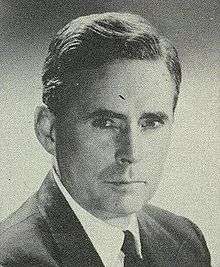James G. Donovan

James George Donovan (December 15, 1898 – April 6, 1987) was an American lawyer and politician from New York.
Life
Donovan was born on December 15, 1898, in Clinton, Massachusetts. He attended the Massachusetts Institute of Technology from 1916 to 1917. He served in the United States Navy during World War I. He graduated from Harvard University in 1922.[1] He graduated from Columbia Law School in 1924. Active in politics as a Tammany Hall Democrat, he was Undersheriff of New York County from 1934 to 1941.
He was a member of the New York State Senate (16th D.) in 1943 and 1944.
In an effort to unseat American Labor Party congressman Vito Marcantonio,[2] in 1950, he ran for Congress on both the Democratic and Republican party ballot lines. He was elected to the 82nd Congress, and won reelection to the 83rd and 84th United States Congresses, holding office from January 3, 1951, to January 3, 1957. In 1956, he ran unsuccessfully for reelection as a Republican after having been denied renomination by Tammany Hall, and was defeated by Alfred E. Santangelo.
After leaving Congress, in 1957 Donovan was New York State Director of the Federal Housing Administration. He then resumed practicing law, and maintained an office in New York City until retiring in 1965.
He died on April 6, 1987, in New York City. He was buried at Woodlawn Cemetery in the Bronx.
References
- ↑ Obituary, James G. Donovan. New York Times. April 7, 1987
- ↑ Jesse Walker, Third Parties: A Beginner's Guide", "Reason.com Hit & Run Blog, March 17, 2016
Sources
- United States Congress. "James G. Donovan (id: D000421)". Biographical Directory of the United States Congress.
- James G. Donovan at Find a Grave
| New York State Senate | ||
|---|---|---|
| Preceded by Thomas G. Brennan |
New York State Senate 16th District 1943–1944 |
Succeeded by William Rosenblatt |
| U.S. House of Representatives | ||
| Preceded by Vito Marcantonio |
Member of the U.S. House of Representatives from New York's 18th congressional district 1951–1957 |
Succeeded by Alfred E. Santangelo |